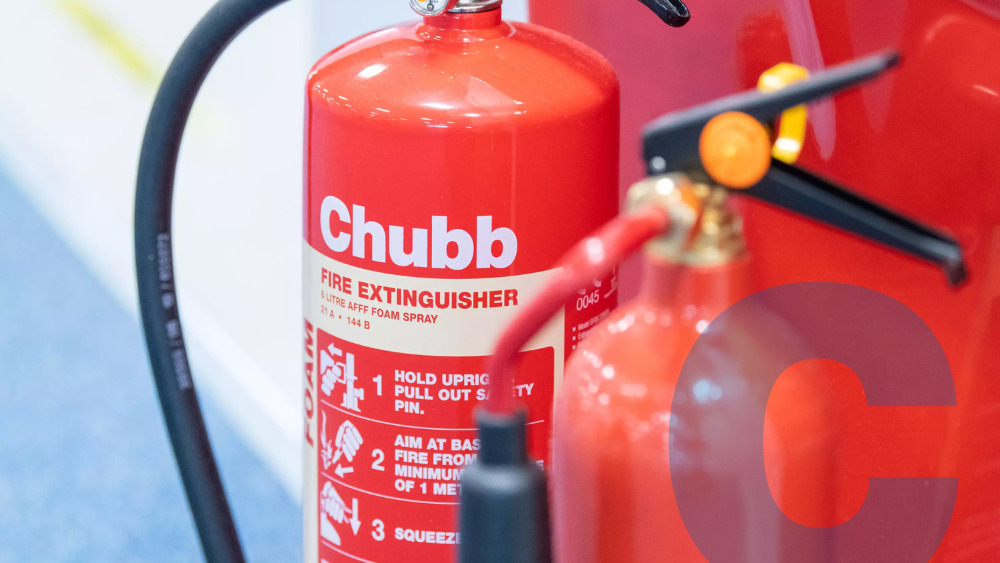



Changes to the extinguisher selection and positioning standard – use of water-based extinguishers on electrics
By Chubb | 21st March 2024
On Thursday 30th November 2023, The British Standards Institution (BSI) published revisions to its BS 5306-8:2023 code of practice. This code of practice provides details on the number of fire extinguishers, what type of extinguisher you should select and when, and where to position the fire extinguishers.
As part of a series of blogs, we’ll be investigating the main changes from previous versions, the reasons for them and how they could affect your organisation.
In our first blog, we’ll be discussing the use of water-based extinguishers on electrics.
A bit of background
All British Standards are reviewed every five years. In 2017, both customers and the fire industry itself were finding some of the clauses confusing and difficult to comply with. As a result, BSI was tasked to provide greater clarity on four key areas:
- Use of water-based extinguishers on electrics;
- Use of powder indoors;
- Guidance on lithium-ion battery fires and
- How best to provide cover on very small floors/storeys.
Confusion around water-based extinguishers
In the 2012 standard, it was stated that only electrically non-conductive extinguishing media, such as non-conductive powder, carbon dioxide (CO2), or other clean agents, should be used on live electrics.
Nevertheless, some extinguisher manufacturers interpreted it unusually, something which BSI may have never intended. As a result, water-based extinguishers with features such as treated water or an innovative nozzle design were strongly marketed as suitable for people to use on fires involving live electrics. These products and their promotion caused a great deal of confusion, especially when it’s well-known that water and electricity don’t mix – something we all learn at school! The misunderstanding needed to be proven one way or the other while the standard sought to safeguard all extinguisher users, taking variable factors into account. Not an easy task.
Bringing clarity to the standard
But BSI made the sought-after determination. The BS5306-8:2023 is 100% clear and warns that water-based extinguishers should not be used directly on electrics as it could result in electrocution. Rather helpfully, the new standard provides us with commentary on how they arrived at this decision. Time to dive a little deeper…
Firstly, the Health and Safety Executive (HSE) states that Electric Shock Injury (ESI) is potentially dangerous at around the public electricity supply frequency. Secondly, it is known that quite low electrical current (only a few milliamps (mA)) can cause ESI and that, thirdly, susceptibility to ESI is increased when a person is in electrical contact with the earth via damp/wet conditions, or by having damp/wet clothing. In summary, even mains electricity can cause injury, and you’re more likely to be injured if the environment is wet.
Finally, BS5306-8:2023 reminds us that, even where electrical cut-off protection is provided in electrical equipment, for example, a printer, a fire can cause the protection to fail leaving the printer live. We are also reminded that the electrical feed to fuse boards will always be live, except where there is a complete grid power cut. Both explain that even if you think something is “dead” because it is on fire, it could well still be live.
Looking at the commentary, it becomes easy to understand why the new standard carries a warning that “use of electrically conductive extinguishing media could result in electrocution.” It is simply making sure everyone is safe every time. It is also comforting that the main message remains – “only electrically non-conductive extinguishing media, such as non-conductive powder, carbon dioxide, or other clean agents, should be used on live electrical equipment.”
What this means for you
Many service providers interpreted the 2012 standard literally, typically providing CO2 extinguishers (alongside water-based extinguishers such as Hydrospray or Foam) to provide a safe means to tackle electrical fires. If your service provider did that, then you have no action to take. If, however, you were persuaded that the treated water or innovative nozzle design was the way to go, then perhaps it’s time to review that decision in light of the new BS5306-8:2023 and the guidance it gives us all.
How we can help
Fire extinguishers have been protecting people and premises for over 200 years. We have the skills, knowledge and people to ensure your fire extinguishers are properly installed and serviced when required. We’re always up to date with the latest regulations and legislation, so you don’t have to be.
Contact one of our experts today – https://chubbfs.com/uk-en/products-solutions/fire/fire-extinguishers/
